
Posted on 12/10/2013 4:34:31 AM PST by Homer_J_Simpson

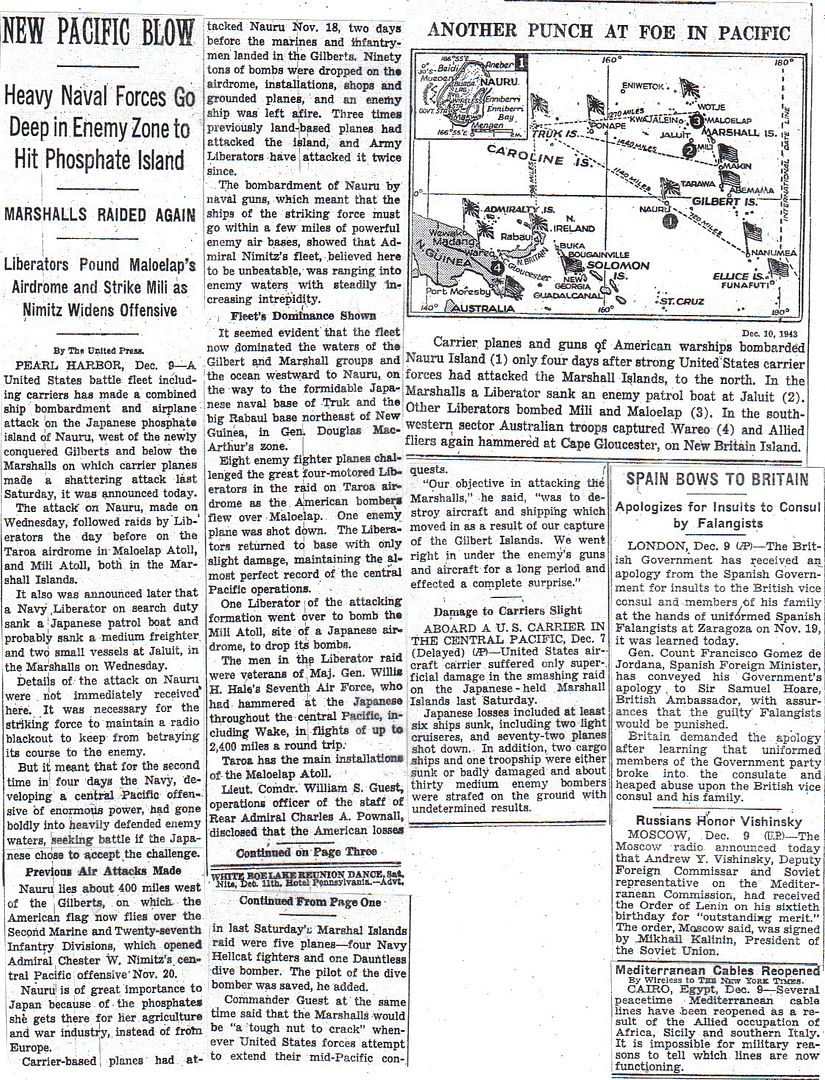
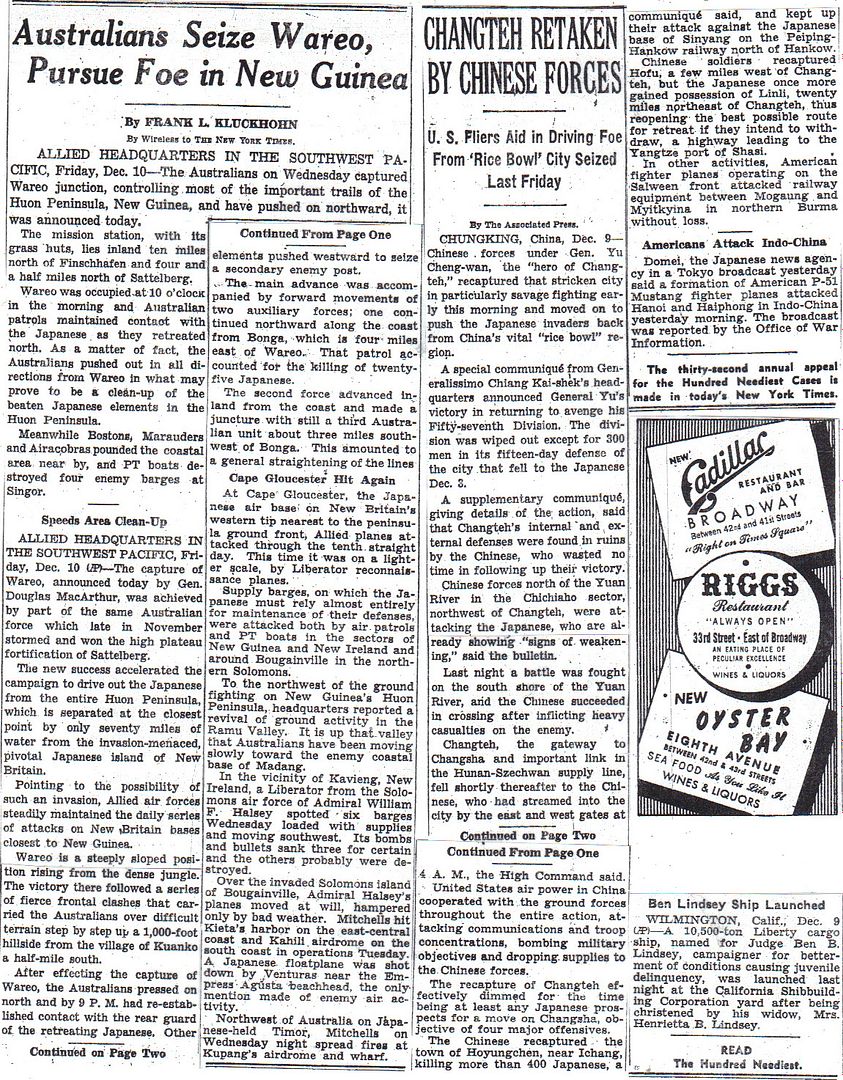
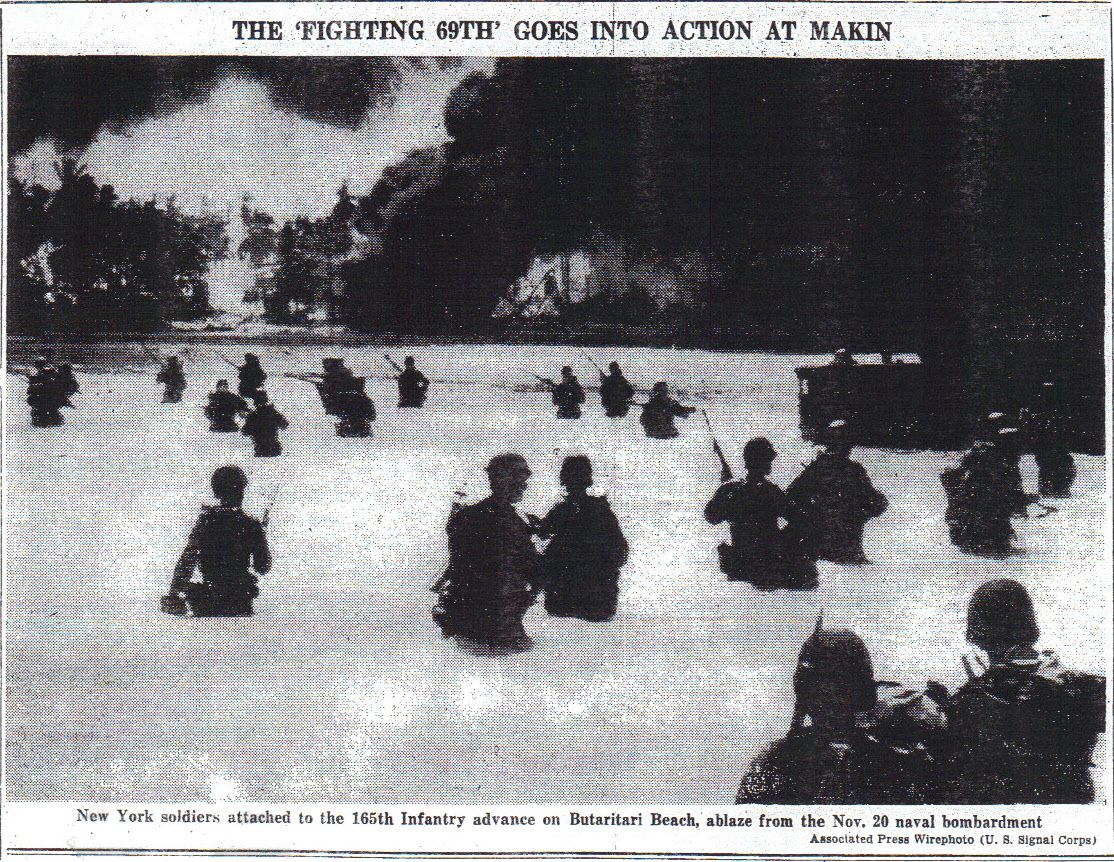
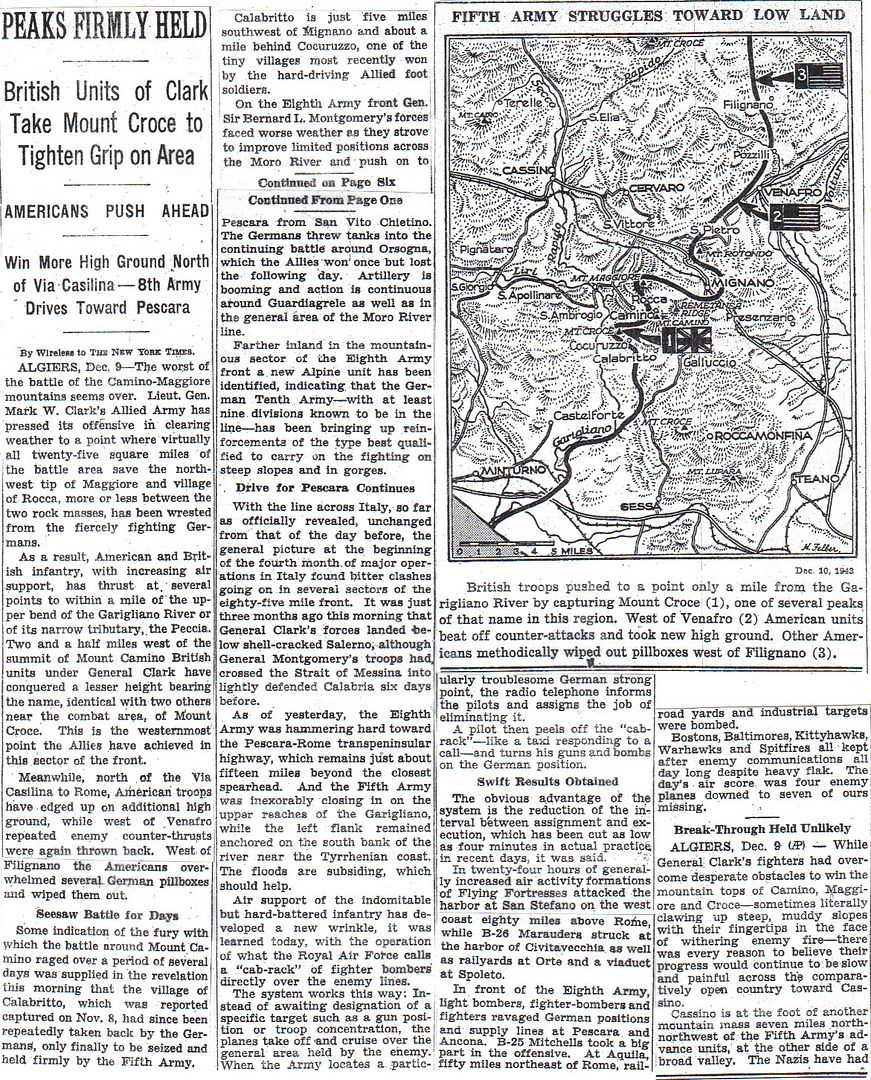
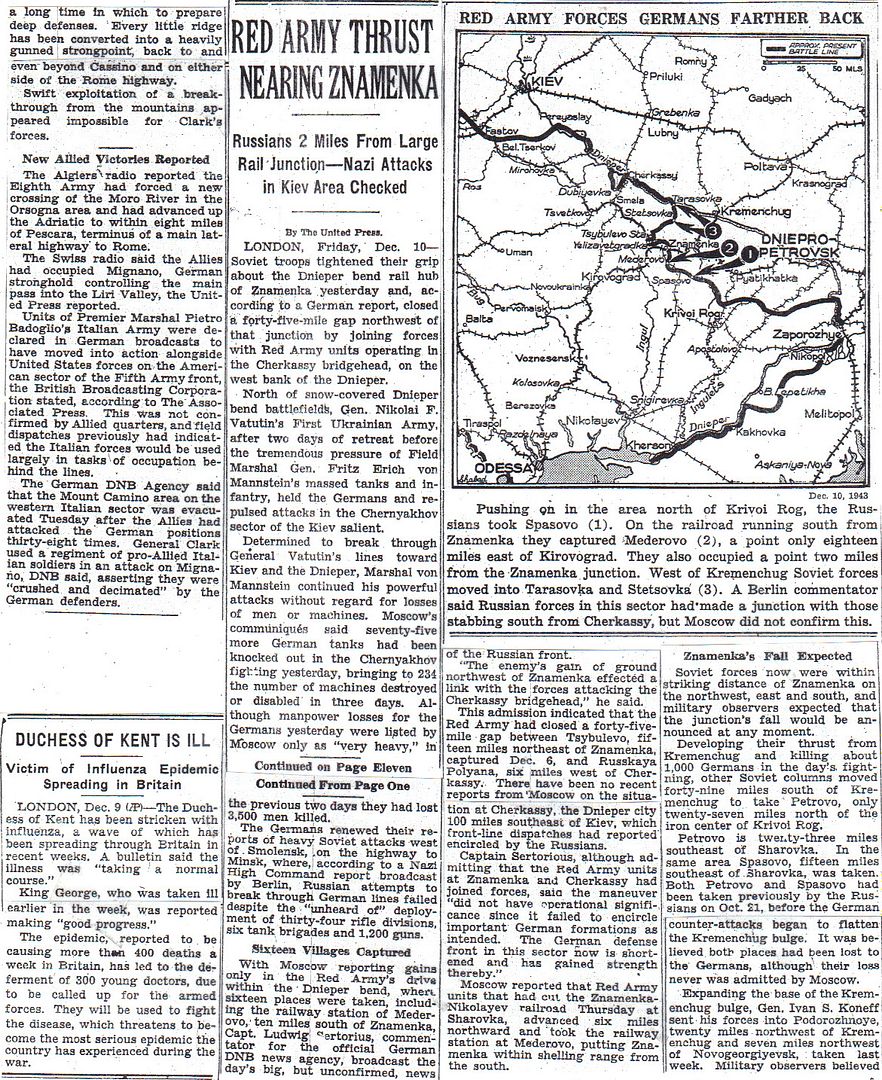
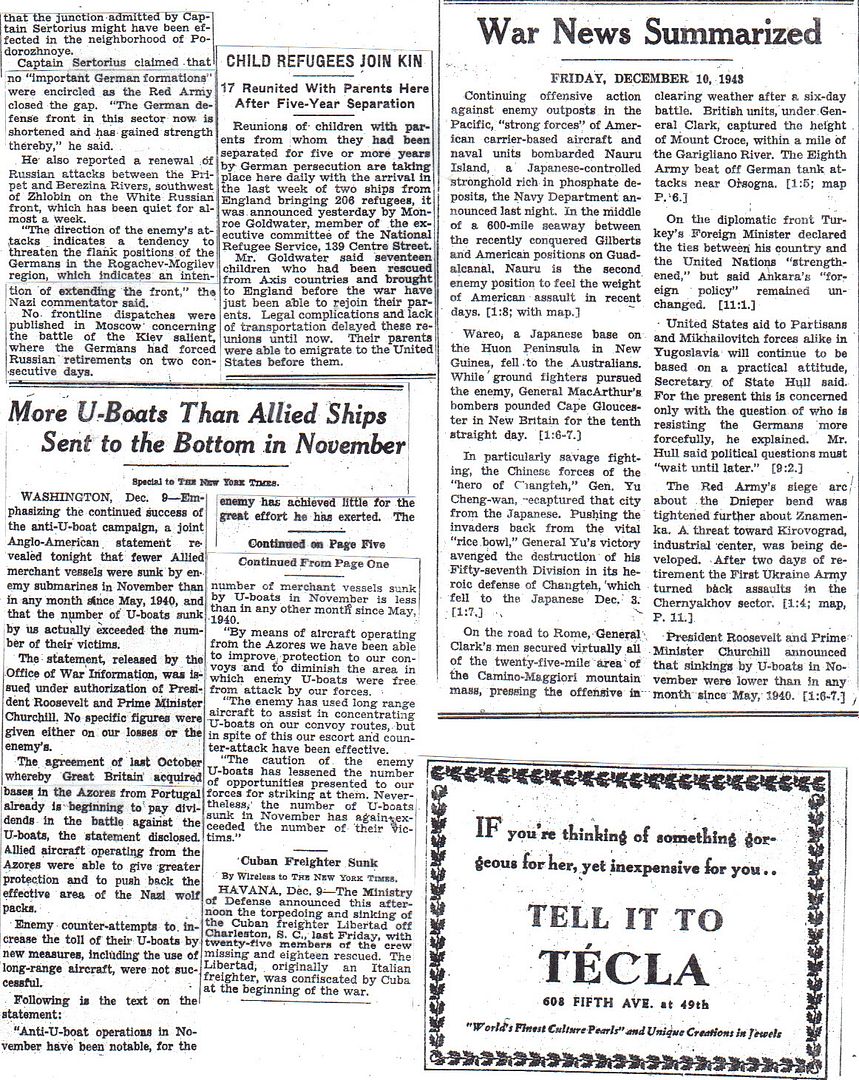

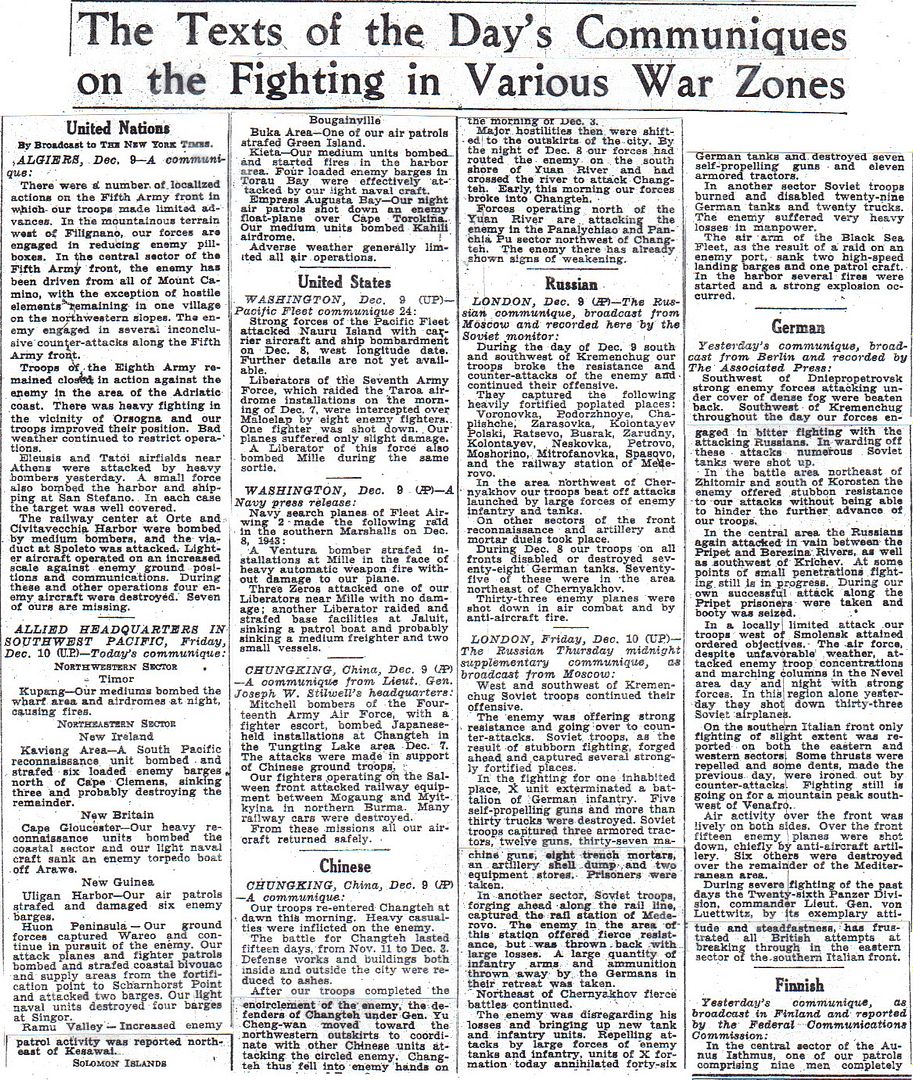
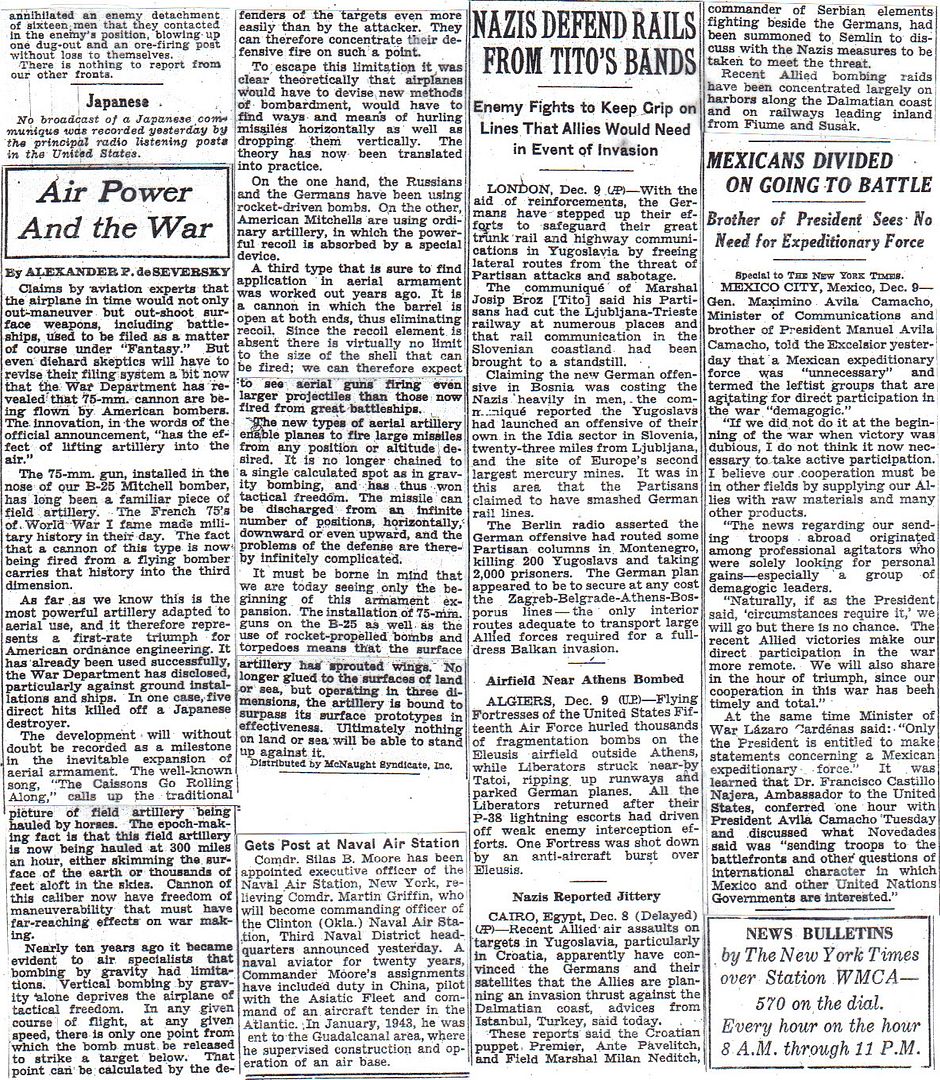
http://www.onwar.com/chrono/1943/dec1943/f10dec43.htm
American planes land on Bougainville strip
Friday, December 10, 1943 www.onwar.com
American medium bombers on a raid over the islands [photo at link]
In the Solomon Islands... On Bougainville, the first American aircraft arrive at the Cape Torokina airfield. American divisions are gradually extending their perimeter.
In Washington... The long-running debate on draft regulations ends with Roosevelt signing into law a revised bill which puts those who have been fathers since before Pearl Harbor at the bottom of the list.
On the Eastern Front... Soviet forces capture Znamenka. Slightly to the north, Konev’s front begins a new offensive.
In Italy... The British 8th Army crosses the Moro River in force.
http://www.etherit.co.uk/month/thismonth/10.htm
December 10th, 1943 (FRIDAY)
UNITED KINGDOM: Twenty German aircraft attack four USAAF Ninth Air Force airfields in Essex, England, Gosfield, Andrews Field, Earls Colne, and Great Dunmow, killing eight and wounding 20+ men.
WESTERN EUROPE: Six USAAF Eighth Air Force B-17 Flying Fortresses drop 1.2 million leaflets on Rouen, Paris, Caen and Amiens, France, and Ghent, Belgium, at 2026-2102 hours.
Destroyer HMS Cambrain launched.
Sloop HMS Lark commissioned.
Destroyer HMS Verulam commissioned.
Minesweeper HMS Plucky commissioned.
Frigate HMS Moorsom commissioned.
DENMARK:
D-DAY COUNTDOWN...
December 10, 1943:
Field Marshal Rommel and his staff continue to tour the Danish coast in their special train.
Leaving Copenhagen, the capital, they proceed with their inspection.
Rommel is discovering that the defence line along the shore here is woefully inadequate.
True, an invasion here is unlikely. There simply are too few beaches for a major landing.
And German air bases are too close for a successful amphibious landing. Still, the preparedness of the troops up here is terrible. It’s one big holiday.
No, he is not satisfied at all. And if this is any indication of what he would find in France...
—Peter Margaritis
FRANCE: Four RAF Bomber Command aircraft drop leaflets over France during the night of 10/11 December.
GERMANY: During the night of 10/11 December, RAF Bomber Command Mosquitos bomb targets in four cities: Two targets are hit in Leverkusen, 14 bomb the I.G. Farben chemical plant and five bomb the city; one each Mosquito bombs Cologne, Duren and Krefeld.
U-877 launched.
BULGARIA: Thirty one USAAF Fifteenth Air Force B-24 Liberators, with fighter escort, bomb a marshalling yard at Sofia. P-38 Lightnings fly weather reconnaissance in the Sofia area.
U.S.S.R.: Znamenka is finally captured by the Red Army. Konev begins a new series of attacks to the north of Znamenka.
Troops of the Second Ukrainian Front resume the attack, one force investing Cherkassy and another pushing toward Kirovo.
ITALY: Canadian troops join the attack on Ortona. Brigadier Syd Thomson takes over command of the Seaforth Highlanders of Canada and together with the Loyal Edmonton Regiment, they set about evicting battle-hardened German paratroops from Ortona, where roadblocks have been erected to force attackers in the few open squares, many of which are ringed with machine guns.
The British Eighth Army has regrouped to increase the weight of an attack in the coastal sector, where opposition is heavy. The XIII Corps, with the 5th Division and the New Zealand Division under its command, is to move north on the left of V Corps, leaving the 78th Division in previous positions under Eighth Army command. The V Corps continues northward along the coast with the Canadian 1st and Indian 8th Divisions. The Canadian 1st Division now has a bridgehead across the Moro River and is pressing toward Ortona, assisted by air and naval bombardment of coastal targets.
In the U.S. Fifth Army area, Allied air attacks are stepped up in preparation for the next phase of offensive, which is to begin on 15 December. The British X Corps takes responsibility for Mt. la Difensa from the U.S. 142d Infantry Regiment, 36th Infantry Division, U.S. VI Corps. In the U.S. II Corps area, the 3d Ranger Battalion, with artillery support, renews an attack on Hill 950 on the northern flank of the II Corps and takes it.
In the U.S. II Corps area, the 3d Ranger Battalion, with artillery support, renews an attack on Hill 950 on the northern flank of the II Corps and takes it. Activity in the St. Pietro area and on Mt. Sammucro is on a limited scale. Current U.S. positions are being consolidated. In the U.S. VI Corps area, the 2d Moroccan Division takes command of the zone previously held by the U.S. 34th Infantry Division.
San Pietro: Hitler himself has reputedly selected this small Italian hill town on the slopes of Monte Sammucro to be the perfect example of a German position, dominating as it does the vital Liri Valley which forms their defensive Gustav Line.
For four days now the battle has raged as US forces struggle to push the Germans from their carefully sited pill boxes. Troops of the 143rd Infantry Regiment managed to reach the barbed-wire defences, but they were cut down by the machine-gun and mortar fire, and sustained 300 casualties before being retired. Tanks are now being called up.
http://history.sandiego.edu/gen/filmnotes/sanpietro.html
http://www.ihffilm.com/22057.html
http://history.sandiego.edu/gen/WW2Timeline/erniepyle3.html
USAAF Twelfth Air Force P-40s and A-36 Apaches attack oil tanks, warehouses, railroads, and vessel at Civitavecchia, the town of Acquafondata, and with Australian, British and South African aircraft, hit tactical targets along the British Eighth Army front, and later strafe road traffic in the Canosa Sannita-Chieti area.
USAAF Fifteenth Air Force B-26 Marauders hit bridge approaches west and east of Ventimiglia.
YUGOSLAVIA: USAAF Twelfth Air Force fighters bomb a vessel in the harbor at Split.
USAAF Fifteenth Air Force P-38 Lightnings fly weather reconnaissance in the Zara area.
MALTA: Roosevelt visits the island, and pays tribute to its long-suffering populace.
President Roosevelt signs a draft (conscription) bill that places all men who were fathers before the US entered the was at the bottom of the list liable for call up. This debate, which has continued since Pearl Harbor, is now ended. Roosevelt sailed very close to the deadline for this bill. In so doing, he flouted his own chairman of the war manpower commission, Paul McNutt, who was in favour of calling up fathers. Maj-Gen Lewis Hershey looks likely to take over as the president’s right-hand man for war manpower administration. He is the director of the selective service commission.
Previously, men were divided into four categories: single men, single men with dependants, married men with no children or with children born since Pearl Harbor, and other married men. From now on the president, reacting either to his own instincts or to his shrewd political reading of his countrymen’s instincts, wants only two categories: fathers and non-fathers.
A Combined Chiefs of Staff directive calling for a unified command—Mediterranean Theater of Operations (Allied)—in the Mediterranean becomes effective, although the Mediterranean Allied Air Forces has not yet been activated.
NORTH AFRICA: The Mediterranean Air Command and North-West African Air Force are amalgamated to form Mediterranean Allied Air Forces, consisting of all operational Allied Air Units in the Mediterranean theater, excluding the Middle East.
CHINA: Japanese aircraft bomb Hengyang Airfield in China; eight USAAF Fourteenth Air Force P-40s intercept one wave of airplanes over the field, shooting down three of them; two P-40s are lost in the combat.
FRENCH INDOCHINA: Twelve USAAF Fourteenth Air Force B-25 Mitchells and 15 P-40s attack the marshalling yard at Hanoi. The warehouse area and railroad station suffer heavy damage.
NEW GUINEA: In Papua New Guinea, USAAF Fifth Air Force B-24 Liberators bomb targets on the Huon Peninsula while 40 B-25 Mitchells and B-26 Marauders bomb supply and bivouac areas and bridges along the Bogadjim Road. P-39 Airacobras strafe barges in the Madang area.
BISMARCK ARCHIPELAGO: USAAF Fifth Air Force B-24 Liberators bomb targets at Cape Gloucester on New Britain Island.
SOLOMON ISLANDS: On Bougainville USAAF Thirteenth Air Force B-25 Mitchells bomb the Kahili supply area and airfield; P-39 Airacobras bomb the supply area and antiaircraft positions at Tonolai and strafe four barges in the harbor; New Zealand (PV-1) Venturas hit buildings at Arigua Plantation.
Marine Fighting Squadron Two Hundred Sixteen (VMF-216) with 17 F4U Corsairs, flies in to operate from Torokina airstrip, which is within 220 miles (354 kilometers) of Rabaul, New Britain Island, Bismarck Archipelago.
CANADA:
Corvette HMCS Fergus laid down Collingwood, Ontario.
Frigate HMCS Lanark launched Montreal, Province of Quebec.
Corvette HMCS New Westminster completed forecastle extension refit Sydney, Nova Scotia.
U.S.A.:
Destroyer escorts USS England, Willis and Thomason commissioned.
Frigates USS Gloucester and Shreveport commissioned.
ATLANTIC OCEAN: A British submarine fired three torpedoes at U-238, but all missed.

DURABLE DWELLINGS OPPOSED BY EXPERT
Interesting short article with all the rebuilding that will need to be done, he proposes useful lives of 20-30 years.
MEXICANS DIVIDED ON GOING TO BATTLE
I guess I never thought much about what went on in Mexico, Central America and South America during the war. Send troop or provide supplies appears to be the debate.
Who told de Seversky about putting 75mm guns in the B25s? He really should get out more. Maybe take a trip to the Southwest Pacific to visit Gen. George Kenney and find out some other innovations he’s come up with. Like packing the noses of B25s with eight .50 cal. machine guns to strafe airfields and light coastal shipping, or the skip-bombing technique that destroyed a convoy, or the parachute fragmentation bombs that allows the bomber to come over the airfield at low level and escape ahead of the blast.
These crazy Americans are coming up with all sorts of bright ideas out in the field, where the only relevant issue is whether it works or not.
“In the first six to twelve months of a war with the United States and Great Britain I will run wild and win victory upon victory. But then, if the war continues after that, I have no expectation of success.”
-Isoroku Yamamoto
Who’s navy is running wild now?
Not quite yet.
43 was a rebuilding year for the USN. The new ships are rapidly coming on line, but it will be another 4-6 months or so before they really hit their stride.
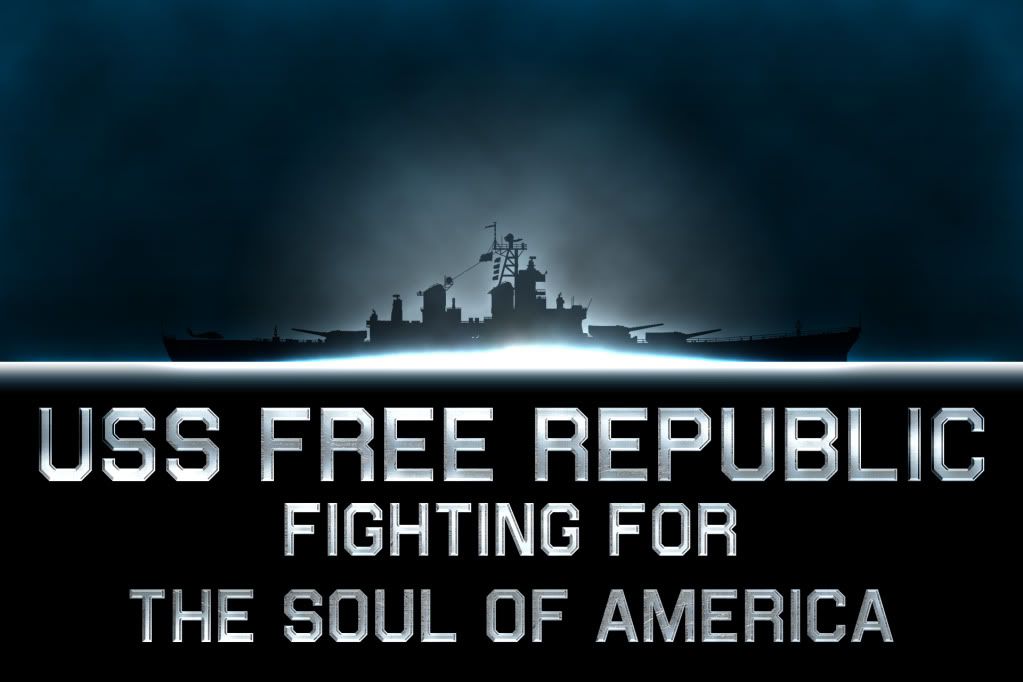
It appears to be an Iowa class battleship after the 1980s refit. Could be any of them.
True, but in the articles in last few days, we are moving at will through the Carolines, and not a trace of opposition. I wonder if we knew just how badly the IJN had been mauled by the heavy fighting in the Solomons in the last year or so. You would think all this poking around their yard would get a response, but they are staying put.
“FRENCH INDOCHINA: Twelve USAAF Fourteenth Air Force B-25 Mitchells and 15 P-40s attack the marshalling yard at Hanoi. The warehouse area and railroad station suffer heavy damage.”
I wonder if any of the WWII pilots who bombed Hanoi returned to do it a couple of decades later?
The British seemed to make a habit of giving the Canadians dirty jobs. I'm thinking especially of Dieppe and the Scheldt campaign.
It’s a legacy of the Somme from the last war; after that debacle, the Canucks and Aussies always got the dirty jobs.
Wasn't just the Canadians. They also gave the Aussies and New Zealanders (and perhaps the South Africans) the high risk jobs.
Disclaimer: Opinions posted on Free Republic are those of the individual posters and do not necessarily represent the opinion of Free Republic or its management. All materials posted herein are protected by copyright law and the exemption for fair use of copyrighted works.